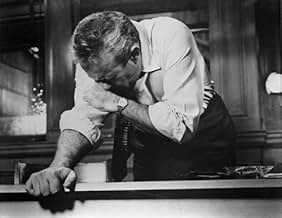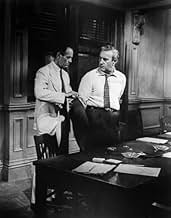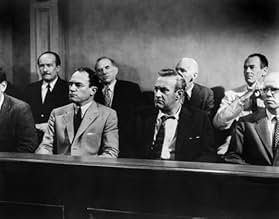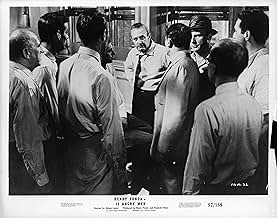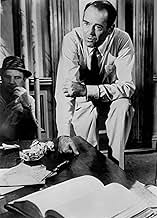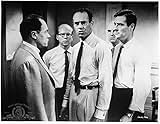O julgamento de um assassinato em Nova Iorque é frustrado por um único membro, cujo ceticismo força o júri a considerar cuidadosamente as evidências antes de dar o veredito.O julgamento de um assassinato em Nova Iorque é frustrado por um único membro, cujo ceticismo força o júri a considerar cuidadosamente as evidências antes de dar o veredito.O julgamento de um assassinato em Nova Iorque é frustrado por um único membro, cujo ceticismo força o júri a considerar cuidadosamente as evidências antes de dar o veredito.
- Indicado a 3 Oscars
- 16 vitórias e 12 indicações no total
- Stenographer
- (não creditado)
- Guard
- (não creditado)
- Court Clerk
- (não creditado)
- The Accused
- (não creditado)
- Man Waiting for Elevator
- (não creditado)
Resumo
Avaliações em destaque
The acting is top notch. I believe that monologue acting is quite a bit simpler than real reactive ensemble acting. Most of what we see today is monologues pretending to be conversations. But in this film, we have utter mastery of throwing emotions. Once the air becomes filled with human essence, it is hard to not get soaked ourselves as the camera moves through the thick atmosphere. Yes, there are slight differences in how each actor projects (Fonda internally, Balsam completely on his skin...) but the ensemble presents one vision to the audience.
The writing is snappy too. You can tell it was worked and worked and worried, going through several generations. It is easy to be mesmerized by this writing and acting, and miss the rare accomplishment of the camera-work. This camera is so fluid, you forget you are in one room. It moves from being a human observer, to being omniscient, to being a target. It is smart enough to seldom center on the element of most importance, so expands the field to all men.
This is very hard. Very hard, to make the camera human. So much easier to do what we see today -- acknowledge the machinery and jigger with it. Do we have a filmmaker today who could do this?
Ted's Evaluation -- 4 of 3: Every cineliterate person should experience this.
Você sabia?
- CuriosidadesDirector Sidney Lumet had the actors all stay in the same room for several hours on end and do their lines over and over without filming them. This was to give them a real taste of what it would be like to be cooped up in a room with the same people.
- Erros de gravaçãoWithin the last half hour of the movie, the clock on the wall in the jury room can be seen indicating 6:15. Several minutes later, E.G. Marshall states that it is "a quarter after six". Several minutes after that, the wall clock is seen again, but still shows 6:15. Still later, when Lee J. Cobb leans over the table after he tears up the snapshot from his wallet, his watch can be seen indicating 5:10.
- Citações
Juror #8: Let me ask you this: Do you really think the boy'd shout out a thing like that so the whole neighborhood could hear him? I don't think so - he's much too bright for that.
Juror #10: Bright? He's a common ignorant slob. He don't even speak good English.
Juror #11: [who has a foreign accent] He *doesn't* speak good English.
- Cenas durante ou pós-créditosAt the end of the film, the actors are billed in order of their juror numbers; thus Henry Fonda, although the star of the film, appears 8th.
- Versões alternativasThe United Artists logo is plastered with black and white versions of the MGM/UA Communications Co./1987 United Artists logo in the 1990 VHS, and 1994 variant in the DVD. But in the 2008 DVD and some TV prints, it featured the colorized opening and closing MGM logos.
- ConexõesEdited into Voskovec & Werich - paralelní osudy (2012)
Principais escolhas
Detalhes
- Data de lançamento
- País de origem
- Idioma
- Também conhecido como
- Doze Homens e Uma Sentença
- Locações de filme
- Empresa de produção
- Consulte mais créditos da empresa na IMDbPro
Bilheteria
- Orçamento
- US$ 350.000 (estimativa)
- Faturamento bruto mundial
- US$ 2.945
- Tempo de duração
- 1 h 36 min(96 min)
- Cor
- Mixagem de som
- Proporção
- 1.85 : 1




